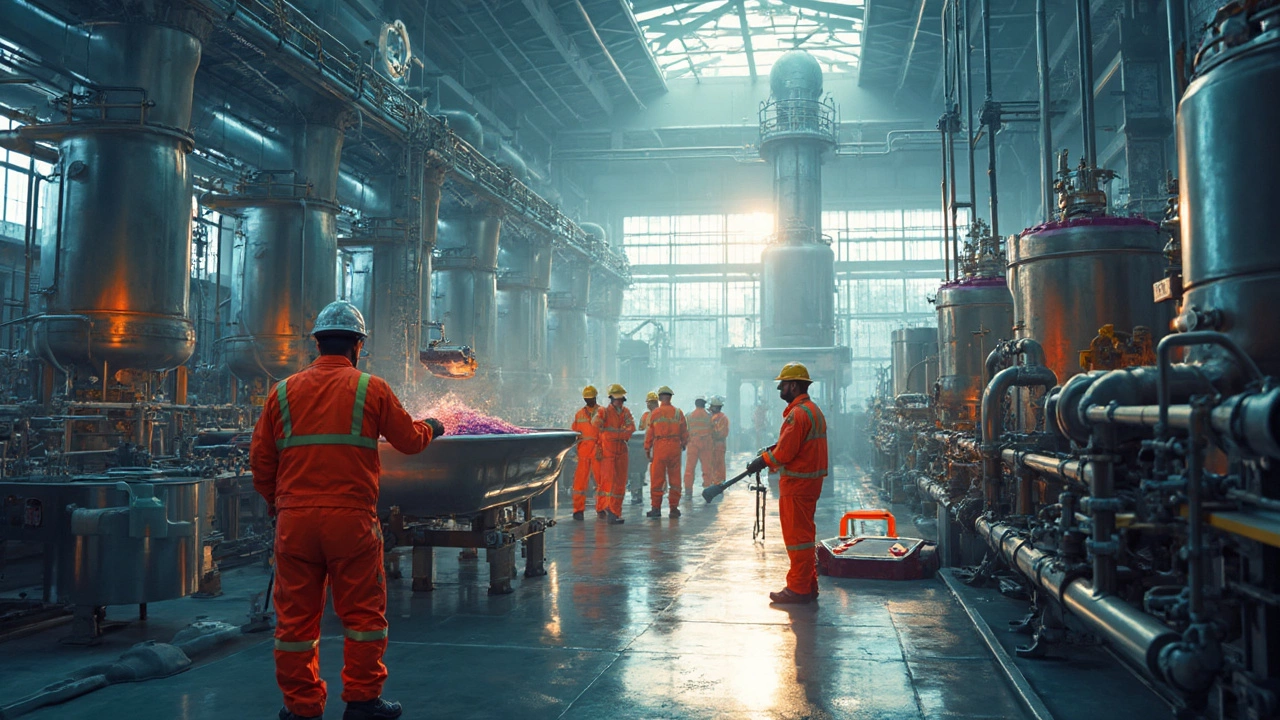The Indian chemical industry is not just about numbers; it's a force to be reckoned with, contributing massively to both the domestic economy and the global market. Could you imagine that? With a broad range of products, from the essential pharmaceuticals to everyday textiles, the industry covers just about everything we encounter in our daily routines.
Spanning several categories, the industry manages to balance traditional chemical manufacturing with cutting-edge technology to drive innovation. That's right, it's not just about generating chemicals but pushing the boundaries of what's possible in today's world. Thanks to recent advancements and a burst of government initiatives, there’s a buzz of excitement around the potential for growth and transformation.
Now, here's why it matters: India's chemical industry holds a significant position in the world market, making it a critical force. It's not just about supplying the global demand, but about playing an active role in setting trends and standards. The industry’s future looks promising with immense potential for investments and broadening its already massive scope.
- Overview of the Indian Chemical Industry
- Key Segments and Their Impact
- Market Trends
- Government Initiatives Driving Growth
- Challenges Faced by the Industry
- Future Prospects and Opportunities
Overview of the Indian Chemical Industry
Talk about massive scale and huge potential—the Indian chemical industry ticks both boxes in a big way. As the world’s sixth-largest, it's estimated to have a market size of over $300 billion as of 2024. Doesn’t that make you just a bit curious about what's driving this giant?
The industry rolls out an impressive variety of products, stretching across bulk chemicals, specialty chemicals, agrochemicals, petrochemicals, and more. These segments don’t just meet local needs—no way! They cater to global markets, making India a significant player on the world stage. Handy, right?
Did you know that the chemical manufacturers in India are a mix of well-established giants and innovative startups? This dynamic blend means the industry isn't just about size; it’s about agility and innovation too. That's what makes it exciting.
Even more, the sector directly or indirectly employs millions of people across the country. Let's break into some specifics: it contributes over 7% to India’s GDP, proving its vital importance to the economy. Plus, the export potential is staggering, accounting for nearly a tenth of India's total exports.
| Year | Market Size (Billion USD) |
|---|---|
| 2020 | 178 |
| 2024 | 300+ |
With so many opportunities, it's no wonder that global investors have their eyes on the Indian chemicals sector. It’s a paving way for more investments, technological exchanges, and collaborations in the future. If anything, the sky's not the limit—it’s just the beginning!
Key Segments and Their Impact
When you think about the Indian chemical industry, it's like a giant mosaic with each segment adding its own splash of color. Everybody talks about its enormous size, but what really makes it tick? Let's break it down.
First off, there's the petrochemicals segment. Imagine this as the backbone of the industry. From plastics to polymers, petrochemicals are where the action starts. They're fundamental not just for industrial applications, but also for products we use every day. Think packaging materials and fuels—big deal, right?
Next up, we have the specialty chemicals. These bad boys serve niche markets and are all about performance—think agrochemicals, dyes, and pigments. Specialty chemicals focus on specific applications, influencing sectors like agriculture and textiles. For instance, if you’ve ever wondered why those colors on your clothes don’t fade easily, you’ve got these guys to thank.
Pharmaceuticals are another heavyweight. India, known as the 'pharmacy of the world,' exports a staggering amount of pharmaceutical chemicals globally. This segment ensures you’ve got access to life-saving medications at affordable prices. The impact is astronomical, affecting public health and the economy alike.
Let’s not forget fertilizers. In a predominantly agrarian economy, fertilizers are crucial for increasing crop yield, which supports the livelihood of millions of farmers. This sector plugs directly into the country’s food security.
Here's a glimpse of their contributions:
| Segment | Contribution to GDP (%) |
|---|---|
| Petrochemicals | ~15% |
| Specialty Chemicals | ~10% |
| Pharmaceuticals | ~30% |
| Fertilizers | ~5% |
The impact of these segments extends far beyond mere numbers. They play a pivotal role in empowering local businesses, generating employment, and positioning India as a global supplier. It’s exciting to see how the synergy among these segments can drive incredible growth in the chemical scene.
Market Trends
Alright, so when we talk about the Indian chemical industry, we're not just looking at a static picture. It's a dynamic landscape with trends that are constantly evolving. Over the past few years, this industry has shown impressive growth rates, largely driven by an increase in demand from various sectors like agriculture, pharmaceuticals, and textiles. What’s more, it’s anticipated to continue growing at a sustainable pace.
One significant trend is the push towards sustainable and green chemistry practices. Consumers are more environmentally conscious, and industries are following suit. Companies are researching and investing in eco-friendly processes, which have become a vital part of their business strategy. Isn’t that a promising shift toward a greener planet?
Also, let's talk numbers! The Indian chemical industry currently stands as the sixth-largest in the world. Looking ahead, projections indicate that it could touch the $300 billion mark by 2025, thanks to its diverse portfolio of products and a relatively lower cost of production compared to other countries.
| Year | Market Value (in billion $) |
|---|---|
| 2020 | 163 |
| 2023 | 207 |
| 2025 (Projected) | 300 |
There's a massive opportunity for growth, especially with digital transformation entering the chemical manufacturing process. From using Artificial Intelligence to optimize production to utilizing data analytics for understanding market demands, digital tools are all the rage. Companies are becoming more tech-savvy, and that's definitely something we should keep an eye on.
Lastly, the government is not lagging behind! Policies and initiatives aim to boost domestic production and reduce dependency on imports. With the Make in India campaign, there's a strong focus on turning the country into a global manufacturing hub.
All in all, these trends present a vibrant picture of where the Indian chemicals industry is headed. Clearly, there's a lot happening, and for stakeholders and investors, the message is clear: now's the time to dive into this thriving industry.

Government Initiatives Driving Growth
In the last decade, the Indian government has rolled out a series of initiatives aimed at bolstering the Indian chemical industry. These measures are not just fancy talk; they've been instrumental in paving the way for impressive growth. Under programs like 'Make in India,' the focus has been on boosting local manufacturing capabilities. This initiative aims to reduce dependency on imports and promote self-reliance, which is great for the domestic economy.
What about the specifics? Well, the government has set up clusters and parks dedicated to chemicals and petrochemicals. These designated spaces allow businesses to thrive with access to essential infrastructure and services. Simplifying the compliance processes through initiatives like the Environment Clearance portal has made it easier for companies to get projects off the ground without unnecessary delays.
On the financial side, schemes offering reduced tax rates and easy financing options have made it attractive for businesses to invest in the chemical sector growth. The Production Linked Incentive (PLI) scheme has further attracted significant investments by offering incentives for enhancing local production capabilities.
Here's a bit of number crunching for you: according to recent reports, the Indian government's proactive approaches have put the country on track to become a $300 billion industry by 2025. That's an achievement worth noting!
Lastly, tackling the environmental aspects, the Indian government is pushing for sustainable practices, emphasizing green chemistry and waste management. This dual approach not only secures growth but also ensures that the industry remains environmentally responsible, aligning with global standards.
Challenges Faced by the Industry
You might think that being one of the giants in the global market, the Indian chemical industry would have it all figured out. But like every major player, it's not all smooth sailing. Several hurdles thrown in its path need attention.
First up is regulatory compliance. With diverse laws varying across states, trying to keep up can feel like running on a treadmill set to maximum speed. Juggling these regulations while meeting international standards is tricky and can slow down progress.
Environmental concerns are another biggie. There's always pressure to shift towards greener, sustainable methods of production, which can be costly and challenging to implement at a large scale. It’s like asking someone to switch their house from being brick-built in a day to an eco-friendly marvel overnight.
Then comes the issue of scale and infrastructure. Think about this: while there's immense potential for growth, the industry's infrastructure sometimes struggles to keep up with the demands. Adequate logistics, supply chain efficiency, storage, and processing capabilities often need upgrades to facilitate growth.
| Challenge | Impact |
|---|---|
| Regulatory Compliance | Slows innovation and increases costs |
| Environmental Concerns | Necessitates expensive eco-friendly investments |
| Infrastructure Gaps | Hampers efficient supply chain management |
Human resources are another factor. Skilled labor tailored to the unique demands of the chemical industry is in short supply. Training and retaining the right talent is vital but requires investment and time.
Despite these challenges, it's important to view them not as roadblocks but as opportunities. Addressing them can lead to innovation, sustainability, and a stronger foothold on the global stage. So, it’s a mix of challenges and untapped potential waiting to be harnessed by the astute participants in this industry.
Future Prospects and Opportunities
When it comes to the future, the Indian chemical industry is looking at a pretty bright horizon. There's been a growing recognition of its role, both nationally and globally, as it stands at the third largest spot in Asia. Thanks to its robust infrastructure and expanding production capabilities, the industry is more than ready to take on the challenges of tomorrow.
One of the key drivers of growth is the increased focus on sustainability and innovation. More companies are investing in green chemistry and sustainable solutions, making sure they're not just producing for today but safeguarding the resources of the future. This shift is expected to open up novel opportunities for partnerships and product development lines.
Government support is another crucial aspect of the burgeoning opportunities. The 'Make in India' initiative and relaxed regulations have really set the stage for foreign investors and joint ventures. These policies are designed not just to boost production but to foster an environment ripe for research and development.
What's even more exciting? The demand for specialty chemicals is skyrocketing, thanks to their increased application across sectors like electronics and automotive. This means there's going to be a rich tapestry of opportunities for businesses that are agile and ready to adapt.
- Pharmaceuticals: With India's role as a leading provider of generic medicines, the chemical industry can only strengthen its ties with the pharma sector, resulting in advanced drug discoveries and innovations.
- Textiles: As fashion industries worldwide seek more sustainable and eco-friendly practices, Indian chemical firms have the chance to develop innovative textile treatments.
- Agrochemicals: Playing a crucial role in India's agriculture-driven economy, the scope here is enormous, focusing on better yields and sustainable farming solutions.
The future is promising, with the industry projected to double in size by 2030. So, whether you're considering investment or collaboration, the Indian chemical industry might just be the winning ticket you've been looking for.
